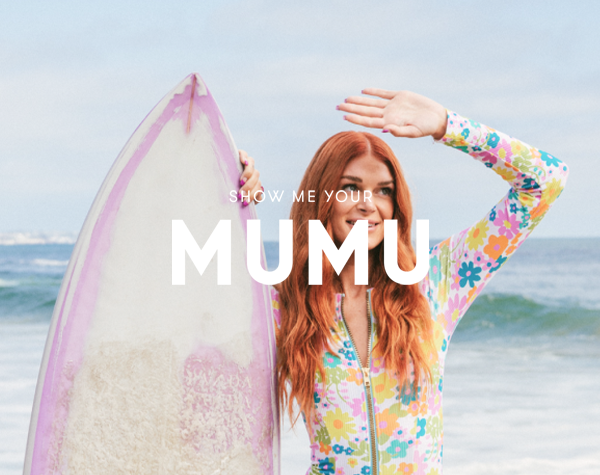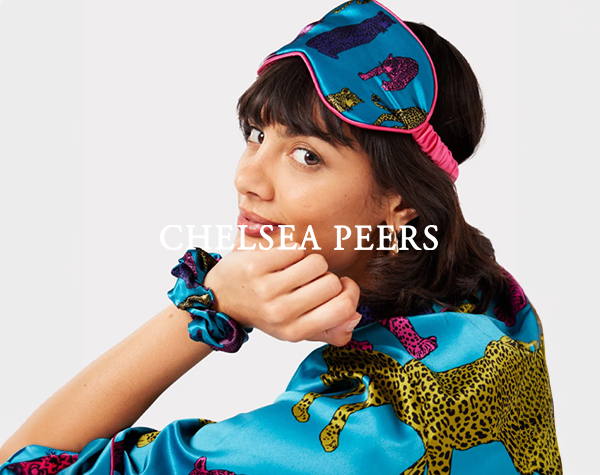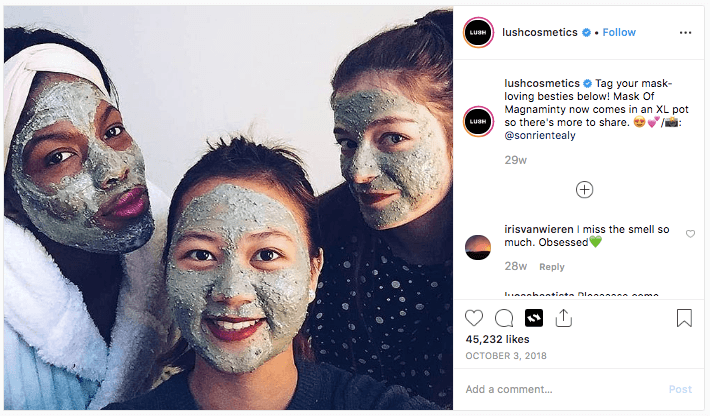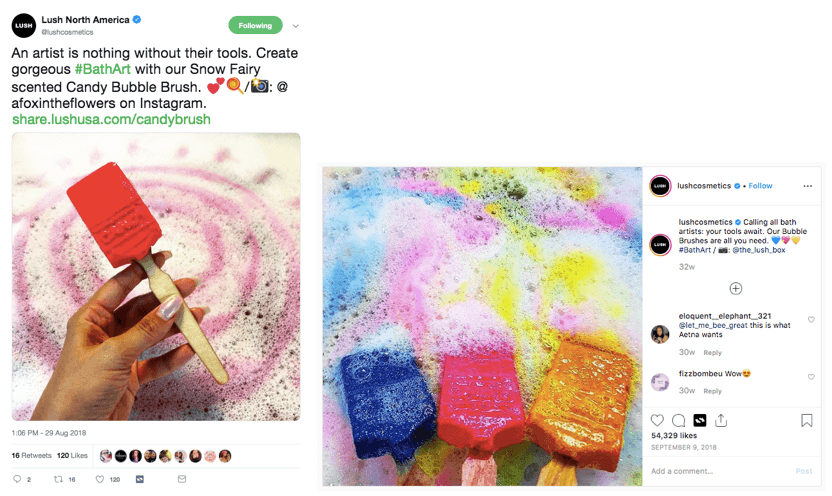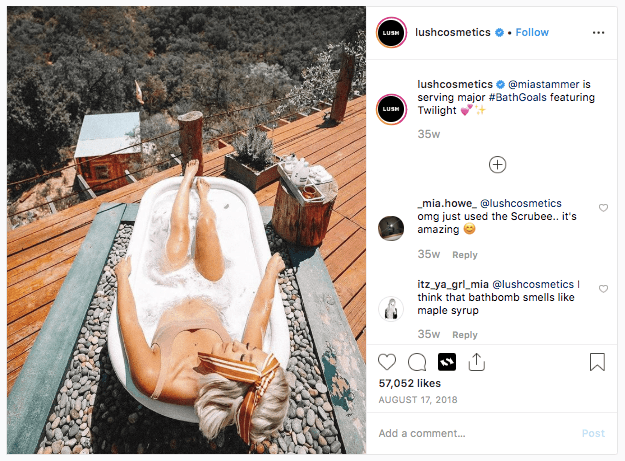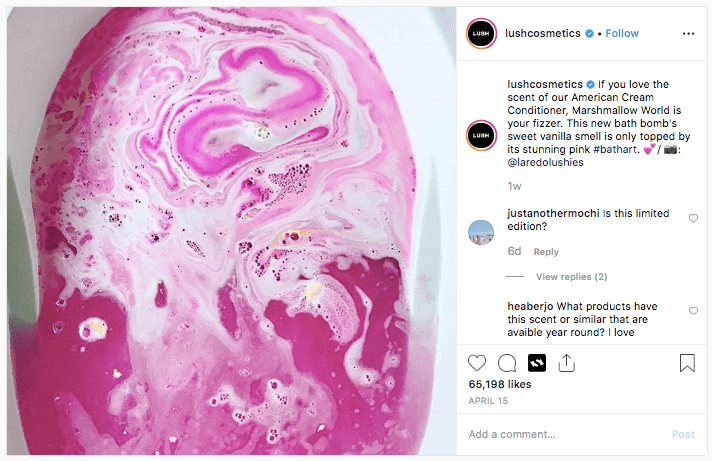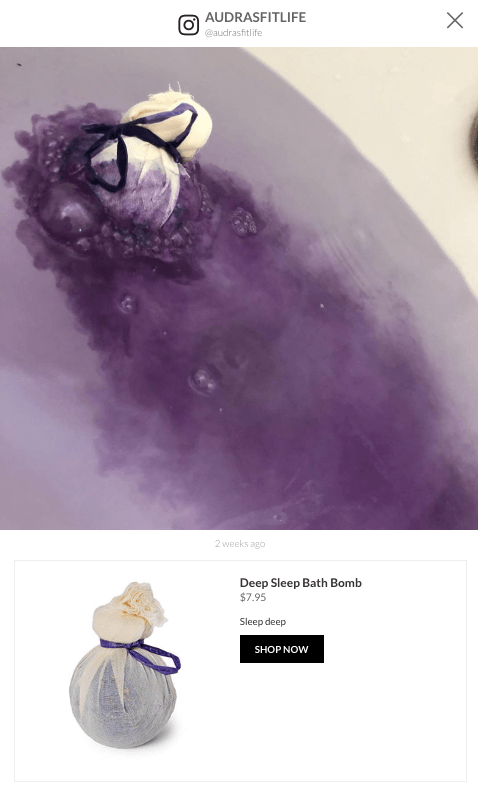
How LUSH Cosmetics Uses User-Generated Content to Transform Customers into an Engaged Community of Brand Advocates
After a long day at work, a long day of traveling or even a long day of nothing at all, there’s no better feeling than relaxing into a hot bath.
LUSH Fresh Homemade Cosmetics knows the power of a perfect bath experience when it comes to transformative self care, and their line of natural bath bombs and skincare products lets customers up their bath game to a whole new, picture-perfect level. With colorful products and iconic branding, LUSH has welcomed and nurtured a community of bath enthusiasts. Now, they needed a way to continue to keep these customers, aptly known as “Lushies,” engaged with the brand.
With a budget in mind, LUSH needed a solution that would allow them to consistently deliver large amounts of impactful content while continuously captivating their community. And, Lushies aren’t just typical customers; they’re loyal brand advocates who connect with the brand not only because of the focus on community engagement and advocacy, but because of LUSH’s commitment to ethical campaigns and promoting change for the betterment of the planet.
LUSH knew they could count on this engaged community for authentic, influential content. “User-generated content is a great way for us to produce larger quantities of content that performs really highly and engages our community,” said Sabine Schwirtz, Community Manager at LUSH Cosmetics North America. “Our consumers are giving us exactly what they want to see. It’s important that we’re listening to those needs and providing what they want.”
LUSH incorporates authentic customer-created content across their social channels and web experiences, all while saving time and budget — and they aren’t stopping there.
LUSH replaces traditional advertising spend with customer-created assets that perform
With their two biggest goals being brand awareness and customer engagement, LUSH knew that the content they serve across the top-of-funnel touchpoints needed to strike a nerve and engage customers right at the point of consideration. But, where most brands would allocate budget toward high-level advertising, LUSH took a different route. Instead, they rely on the content they know they’ll see the most return on: genuine and engaging customer-created content from their community.
“User-generated content is the primary way we’ve been running our business for a long time,” Schwirtz said. “It’s the new version of word-of-mouth marketing on social media; for us, it’s important to ensure that customers are engaged enough to create UGC — that engagement will eventually lead to them making more purchases in the future.”
Because LUSH opted to rely on the active engagement of the LUSH community rather than ad spend to boost brand awareness, the team knew they needed a centralized location to store the valuable and influential content that was being created about the brand. “A huge reason why we decided to sign on with Stackla was because of the management and sourcing of all of this content all in one place. As a brand, LUSH can have 500,000 hashtag uses and Instagram tags in just one month. It’s really important that we’re able to manage that content effectively, and Stackla is very helpful with that,” said Schwirtz.
With the tools in place to effectively serve the impactful UGC across their brand channels, LUSH has been able to adapt quickly to any necessary changes in content. As with many CPG (consumer packaged goods) brands, products are often subject to change based on manufacturing, inventory, logistics and other factors. “With Stackla, we’ve been able to react faster — in most cases, when a last minute change arises, we’ve been able to use Stackla-powered UGC on social and on the website in place of planning, booking and paying for a photoshoot,” said Schwirtz. “We’ve been able to utilize Stackla to be more reactive instead of having to worry about large-scale spending.”
With Stackla-powered user-generated content at the heart of LUSH’s digital engagement strategy, the brand saw doors open to implement this authentic content across more of their marketing strategies — redefining their best practices.
When people create the content they want to see, personalization matters — no matter the scale
Without a significant budget for ad spend, let alone targeting, LUSH looked to their audiences to develop a strategy that would serve customers the right content at the right time. “Our personalization is really organic and based off of what users want,” said Schwirtz. “I firmly believe that people create the content they want to see.”
[click_to_tweet tweet=”“I firmly believe that people create the content they want to see.” – Sabine Schwirtz, @lushcosmetics. #LUSHCommunity” quote=”“I firmly believe that people create the content they want to see. – Sabine Schwirtz, @lushcosmetics #LUSHCommunity””]
By sharing the content customers create across LUSH social channels and web pages, the brand automatically aligns itself with the users who organically created that content — nurturing a personalized experience for not only that customer, but all of the other loyal advocates who create similar content. “That level of personalization seems small, but if it means that 500,000 people will resonate with a post on a really deep, personal level instead of our 4 million followers on a surface level, then those 500,000 will have more buy-in to the brand and more buy-in to those products,” said Schwirtz.
With more touchpoints now than ever before, each customer expects a personalized experience at each stage of the buyer’s journey. “You can’t just repurpose the same piece of content across six touchpoints — the customer will tap out and get bored,” advises Schwirtz. “We needed to figure out how to utilize different pieces of user-generated content for specific audiences in a variety of different ways.” Below, LUSH publishes different UGC images on Twitter and Instagram to promote the same product.
Varying UGC across channels can evolve from a broad range of starting points. For direction, LUSH again looks to their customers to know what content actually resonates. “Our customers have specifically demanded more live streams,” said Schwirtz. “We think that request ties into how authentic our brand is, but also our customers’ desire for personalization. Live streams are essentially a conversation between you and your audience.”
By simply paying attention to the content their customers are creating, and listening to their needs — customers know their skin best — LUSH can provide the level of personalization that turns one-time customers into loyal brand advocates. “I don’t think we’d be able to be as personalized or authentic without the UGC capabilities that Stackla has given us,” says Schwirtz.
“I don’t think we’d be able to be as personalized or authentic without the UGC capabilities Stackla has given us.”Sabine Schwirtz, Community Manager, LUSH Cosmetics
These personalization efforts drive a shift toward a more authentic brand voice — and it doesn’t go unnoticed. “The number one question our staff gets asked is ‘What’s your favorite product?’” said Schwirtz. “We know that consumers are really passionate about looking for reviews, and they want to talk to their friends about the products they use. We can see authenticity bleeding through all components of marketing now, and that means a greater shift toward UGC.”
Engaging with influencers on a micro-micro level
Keeping an emphasis on authenticity in mind, LUSH wanted to establish a way to build relationships with their happy customers who had amassed an organic following in the skincare industry. However, they didn’t want to be sourcing images that didn’t fit with the brand’s commitment to real content. “At this time, we’re not paying for #ad or #sponsored posts from influencers,” said Schwirtz. “I think audiences can pick those out really easily, and, to us, they’re less trustworthy.” Instead, LUSH partners with like-minded influencers with similar values; they create UGC-style LUSH content by their own prerogative. “The influencers we work with are posting something because they actually love something. I think our audiences can see the difference.”
In addition, the team works heavily with what they call “micro-micro influencers”: people who have connected with LUSH products and have already engaged by posting a piece of content about the brand. “A micro-micro influencer might have posted one photo in a face mask, so we include them in our Ambassador Program, #FirstLookLushies, which gives them further information about the brand, and in turn, they create more UGC,” said Schwirtz.
By acknowledging and encouraging customers who organically create content about the brand, LUSH fosters an engaged community of loyal organic influencers they can rely on for impactful content to feed the brand’s channels. “They’re more motivated and they have more buy-in to the product because we’re communicating directly with them. We love micro-micro influencers!
Striking the right relationship with influencer content helps LUSH maintain a community-driven brand, and Schwirtz recommends other brands try this balance as well. “I think many marketers who have been in the industry for a long time are worried about maintaining the voice of the brand,” she said. “But, the voice of the brand is not always the same as the voice of the customers. We’re moving closer to times where a brand’s identity is the same as their customers’ identity.”
LUSH engages with its audience, and in return the customers engage back, creating a positive feedback loop that thrives on the trust that LUSH has earned through their rich UGC strategy.
Expanding UGC use cases across the brand — and increasing engagement at each touchpoint
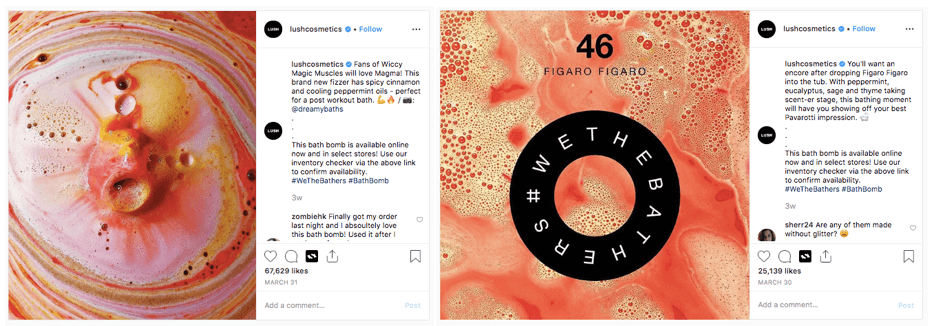
LUSH leveraged this rich user-generated content across their social channels — and saw results. When the team tested their content by publishing both UGC photos and branded content on Instagram, the user-generated images out-performed similar branded images they had created in-house, achieving:
- 1340 percent higher total reach
- 183 percent more new profiles reached on average
- 53 percent higher clicks
- 43 percent greater traffic to their site
And, when compared to the Suggested Item Feed on a product page, the Stackla #WeTheBathers UGC feed received 450 percent more clicks. With results like these, it’s clear that not only are more new customers finding the UGC images on Instagram, but they’re more inclined to engage with the content by clicking through to the website.
After seeing such consistent success with UGC photos on Instagram and their other social channels, LUSH wanted to expand their impactful content strategy. “People often think UGC is only fit for social channels, but UGC can be used in a variety of marketing techniques,” said Schwirtz. And, that authentic content performs at each touchpoint. “We know that communicating with a friend is often a first touch for our customers — seeing UGC is that same action.” And, the numbers back up that logic. According to our recent report, 58 percent of people say content from friends, family or other consumers is the most influential when purchasing beauty, health or wellness products. LUSH now relies on Stackla to curate 95 percent of all of their user-generated content.
[click_to_tweet tweet=”On average, @lushcosmetics UGC reaches 183% more new profiles on Instagram and drives 53% more click-throughs to LUSH’s site than branded content with @stackla. #LUSHCommunity” quote=”On average, LUSH UGC reaches 183% more new profiles on Instagram and drives 53% more click-throughs to LUSH’s site than branded content.”]
LUSH chose to not only feature UGC at the bottom of their homepage, but also make that inspirational content actionable by including ShopSpots that take visitors directly from the UGC to that product’s page. In March alone, this section of the homepage had 1 million impressions — a 333 percent increase from the branded content in the gallery. And, 2 percent of visitors actually took an action on this Stackla-powered UGC after being presented directly with the “Shop Now” button.
Not only is the UGC engaging, but it’s driving actions and compelling consideration. “We even shared a piece of UGC at the bottom of one of our landing pages, and we had forecasted that that product wasn’t going to sell as well,” said Schwirtz. “But, the UGC image was so vivid that it was drawing people to that product page, and we actually sold out in advance of what we thought.”
That product was only featured on that one location in the gallery on the homepage — it didn’t have a feature in the navigation bar, or any other path to get to the product page — but, from the gallery alone, it still sent thousands of visitors to the product page. “We’ve found that not only are people creating content about the products they like, but they’re quickly convinced and they’re making purchasing decisions based on other peoples’ UGC,” said Schwirtz.
Putting marketing back in the hands of the consumers
LUSH’s commitment to listening to the needs of their customers is palpable. By tending to what customers want, LUSH can foster an ongoing conversation that serves to cater to the interests of their community, nurturing loyalty and retention.
As Schwirtz says, “We’re using UGC to answer questions for our customers. ‘How long do I leave a mask on?’ ‘How much face mask do I put on?’ ‘What does the bath bomb look like when it’s inside the water?’ We can answer the questions for them by using UGC (and without really saying anything). A customer’s photo wearing the face mask shows them how much mask to put on their face.”
By listening and providing the information they know their customers want via authentic and compelling visual proof, LUSH can usher customers along the buyer’s journey. “When we put those UGC photos on the landing pages, people make quicker purchase decisions because they have less questions,” said Schwirtz.
“When we put those UGC photos on the landing pages, people make quicker purchase decisions because they have less questions.”
With success across their marketing channels with UGC, LUSH has struck the right content balance. Schwirtz looks forward to the future of UGC in LUSH’s content marketing strategy. “Ultimately, more marketers should be pushing to engage more with their audience,” she says.
Here at Stackla, we couldn’t agree more.
Other case studies


